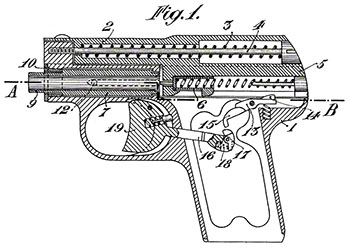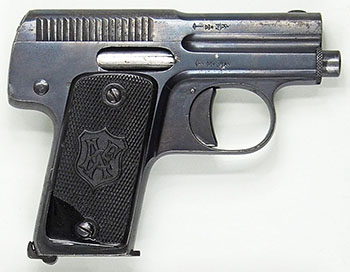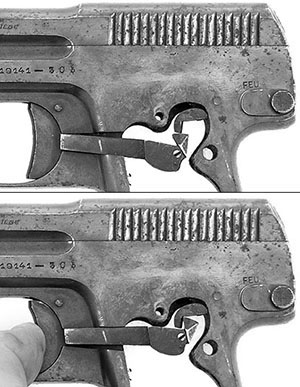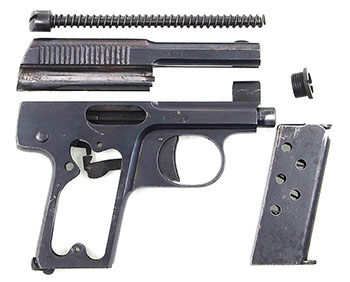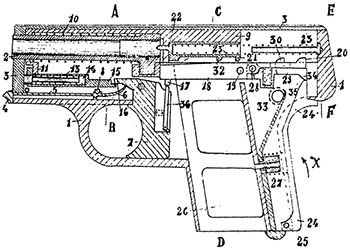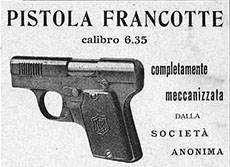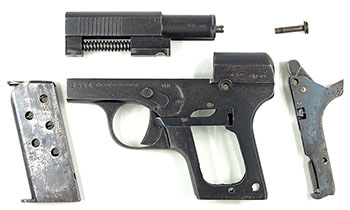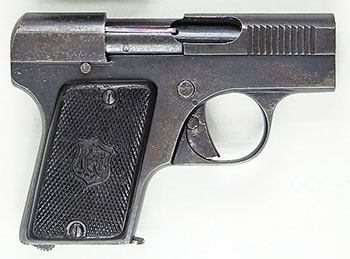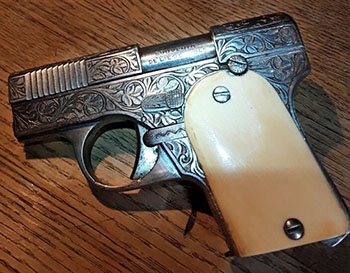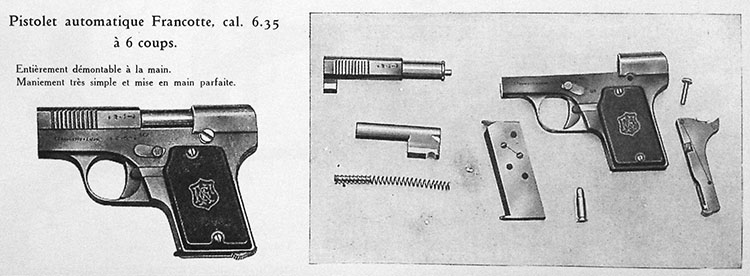 |
|||||||||||||||||||||||||||||||||||||||||||||||||||||||||||||||||||||||||||||||||||||||||||||||||||||||||||||||||||||||||||||||||||||||||||||||||||||||||||||||||||||||||||||||||||||||
|
The Francotte Automatic Pistols by Ed Buffaloe
Only a few books mention that the Auguste Francotte company manufactured an automatic pistol, sometimes referred to by the initials AFC, after the monogram on the grip plates. Matthews, Hogg & Walter, and Zhuk show only what I am calling the Second Model. Hogg and Walter state that the Second Model was made in 1912, and Zhuk gives 1912-1914; many on-line sources have repeated these incorrect dates. The only book, that I am aware of, that mentions the First Model Francotte is the Pistolen Atlas: Archiv für Militär- und Waffenwesen by Karl R. Pawlas. Pawlas does not offer dates for either gun. The First Model was patented in 1913, and manufacture probably began at least by that year. Production may have ceased or been curtailed soon after the beginning of the first world war in August of 1914, which would account for the scarcity of the First Model Francotte. Perhaps the tools for making the First Model were looted or destroyed during the war. The Francotte catalog for 1912 does not list the gun, and I have been unable to locate a catalog for 1913 or 1914. Production of the Second Model certainly began sometime after World War I. Please write to me if you can provide additional information regarding either Francotte automatic pistol.*
I
The First Model Francotte design is similar to many that proliferated in the first decade of the 20th century: a striker-fired, unlocked breech gun in 6.35mm (.25 ACP) with the recoil spring above the barrel. The inventors make claims only for the design of the lockwork and the removable barrel. When fieldstripped, the gun breaks down into two main components, a breech-block/slide and a frame with attached barrel. The magazine and recoil-spring/guide rod form two additional minor components. The barrel is press-fit into the frame and held in place by a threaded bushing at the front. An external slot in the right side of the barrel fits over a pin in the side of the frame to prevent the barrel from rotating. The sear is a lever that rotates on an axis pin. The rear arm of the sear is tensioned upward by a small coil spring. The external transfer bar, which is fixed to the trigger, has a spring-loaded release mechanism at its rear that presses directly upward on the front beak of the sear when the trigger is pulled.
The magazine is of the conventional box type, and holds six rounds. It has five witness holes for viewing cartridges. It also has a slot on the rear that appears to be designed to hold the magazine about one-half inch below the base of the grip, as if for single-shot shooting, but there is no mechanism for holding the slide open, making the loading of single cartridges difficult. The slot is, however, perfectly shaped to fit the front portion of the magazine release, so I have little doubt this is what it was intended for. The magazine release is of unusual design, curving around to the back of the grip strap; the shooter presses up on the rear portion of the release and the magazine falls out of the grip. The fit and finish of the First Model Francotte is of high quality. The company, after all, had an established reputation to uphold. However, they were not made with interchangeable parts, and had to be hand fitted. There is a tiny raised front sight and a rear sighting groove at the top of the slide. The gun is marked on the left side of the slide in italic serif characters as follows: A.FRANCOTTE A LIÈGE and on the left side of the barrel in non-italic serif characters: – BREVET № 19141 – followed immediately by the serial number. The serial number is also stamped on the bottom of the slide. The frame is stamped beneath the left grip with the crown over AF mark of the Auguste Francotte company. The grip plates are of hard rubber with the AFC monogram in a shield in the center. I have documented serial numbers for the First Model from 305 to 1113. It appears that less than 1200 were made. The final serial number documented has its slide inscription in all capital sans-serif characters, as follows: A.FRANCOTTE A LIEGE Two of the First Model Francotte pistols I have documented (serial numbers 868 and 1003) have generic grip plates, lacking the AFC monogram, and also lack the slide inscription that reads “A. FRANCOTTE A LIÈGE.” These guns may have been made during or just after World War I. It is well known that the supply chain for grip plates was disrupted by the war, and many guns in this time period were not fitted with their standard grip plates. This is also consistent with the possibility that late guns were assembled from parts–the machinery for making the guns perhaps having been damaged or appropriated during the war.
All documented examples bear the typical Liège proofmarks, usually on the right side of the slide and frame, just above the trigger. Fieldstripping the First Model Francotte
There is no need to unscrew the barrel bushing for routine maintenance.
Precise dating of the Second Model is not possible at the time of this writing. It may have appeared immediately after the war in 1919 or 1920, but I have no direct evidence. The earliest source that can be dated is an Italian advertisement that appeared in mid- to late-
The Second Model Francotte is an unlocked breech, hammer-fired 6.35mm pistol with the recoil spring situated beneath the barrel. The gun breaks down into three modules: (1) the frame which contains the trigger, transfer bar, safety lever, and magazine; (2) the backstrap which contains the hammer, sear, and magazine release; and (3) the breech block/slide which contains the barrel, firing pin, and recoil spring. The barrel and recoil spring are easily removable from the breech block/slide.
The frame is unusual in that it has a housing on top into which the breech block/slide recoils. The slide is unusual in that it has serrations at the front. The backstrap is unusual in that it is removable from the gun as a unit, and the entire backstrap rotates on an axis pin at the top when the magazine release is pushed to the rear. The Second Model’s modular design was well ahead of its time. The safety lever has a round checkered grasping surface, and comes to a point at its rear. When turned upward (covering the word FEU on the frame and revealing the word SUR) it appears to block the slide–this is simply a visual reminder that the safety is on–it does not immobilize the slide. The safety lever can be rotated in a clockwise direction, and when pointed forward frees the slide and barrel for removal from the frame.
There are eleven coarse triangular-cut serrations at the front of the slide. Grip plates are of checkered hard rubber with the AFC monogram in a shield in the center. The magazine holds six cartridges and is nearly identical to that of the First Model, with five witness holes on each side , except that it lacks the hole in the rear to hold the magazine in a lower position. Guns up to at least serial number 1441 are marked on the left side of the frame in italic sans-serif characters as follows: A.FRANCOTTE A LIÈGE The serial number is on the frame either below or in front of the inscription. The serial number is also found on the base of the barrel, the base of the front post of the slide, and the side of the backstrap. The Second Model Francotte has its own serial number range; I have documented numbers from 1 to 4097, so at this time I estimate not many more than 4100 were made. Some later guns have no barrel, grip plates, or proofmarks and may simply represent leftover parts. I have documented two guns (SNs 2008 and 3602) with a frame inscription in all capital sans-serif characters as follows: A.FRANCOTTE A LIÈGE All guns documented after serial number 2008 do not have a frame inscription, with the exception of 3602. Beginning at least with SN 811, guns are marked on the left side of the upper frame housing “6 35 BR”.
Three late guns, serial numbers 3362, 3408, and 3485, do not have proof marks of any kind. It is possible that these guns were sold as late as the German occupation of Belgium during World War II. I have documented two guns that are engraved in different styles and are nickel plated. These guns do not have serial numbers or proof marks, and neither has the AFC monogram grip plates. One, which appears on the littlegun.be website, is inscribed on the right side of the frame SOUVENIR DE LIÈGE BELGIQUE. The other gun, in a private collection, is similarly engraved on the left side of the breech block SOUVENIR DE LIÈGE 1945. I speculate that these two guns, and possibly others, were made from leftover parts during the German occupation of World War II. The second model Francotte pistols were not made with interchangeable parts, and so required hand fitting of each gun, as anyone may discover if they try to swap parts from one gun to another. Please write to me if you have a Second Model Francotte and are willing to share information about it.*
Fieldstripping the Second Model Francotte
* Write to edbuffaloe@unblinkingeye.com. |
|||||||||||||||||||||||||||||||||||||||||||||||||||||||||||||||||||||||||||||||||||||||||||||||||||||||||||||||||||||||||||||||||||||||||||||||||||||||||||||||||||||||||||||||||||||||
|
|||||||||||||||||||||||||||||||||||||||||||||||||||||||||||||||||||||||||||||||||||||||||||||||||||||||||||||||||||||||||||||||||||||||||||||||||||||||||||||||||||||||||||||||||||||||
|
Copyright 2021-2025 by Ed Buffaloe. All rights reserved. |
|||||||||||||||||||||||||||||||||||||||||||||||||||||||||||||||||||||||||||||||||||||||||||||||||||||||||||||||||||||||||||||||||||||||||||||||||||||||||||||||||||||||||||||||||||||||
|
|
|||||||||||||||||||||||||||||||||||||||||||||||||||||||||||||||||||||||||||||||||||||||||||||||||||||||||||||||||||||||||||||||||||||||||||||||||||||||||||||||||||||||||||||||||||||||

